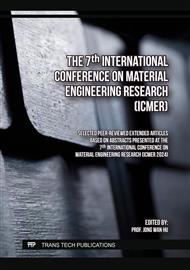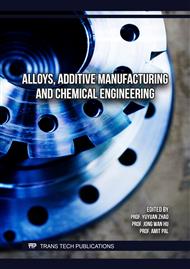[1]
T. Kong, D. Nhg DR, V.T. Shi, Method for optimizing energy consumption in machining manufacturing process, Mathematical problems in engineering, (2022), Article ID 8300666.
DOI: 10.1155/2022/8300666
Google Scholar
[2]
J. Ma, X. Ge, S. I. Chang, S. Lei S, Assesment of cutting energy consumption and energy efficiency in machining of 4140 steel, Int. J. Adv. Manuf. Technol. 74 (2014).
DOI: 10.1007/s00170-014-6101-3
Google Scholar
[3]
G.Y. Zhao, Z.Y. Liu, Y. He, H.J. Cao, Y.B. Guo, Energy consumption in machining: Classification, prediction, and reduction strategy. Energy 133(15) (2017) 142-157.
DOI: 10.1016/j.energy.2017.05.110
Google Scholar
[4]
Q. Wang, F. Liu, X. Wang. Multi-objective optimization of machining parameters considering energy consumption. Int. J. Adv. Manuf. Technol. 71 (2014) 1133-1142.
DOI: 10.1007/s00170-013-5547-z
Google Scholar
[5]
J. Lv, R. Tang, W. Tang, Y. Liu, Y. Zhang, S. Jia. An investigation into reducing the spindle acceleration energy consumption of machine tools. Journal of cleaner production. 143 (2017) 794-803.
DOI: 10.1016/j.jclepro.2016.12.045
Google Scholar
[6]
SAA. Bagaber, A.R. Yusoff, Sustainable optimization of dry turning od stainless steel based on energy consumption and machining cost. 8th CIRP conference on high performance cutting (HPC), Procedia CIRP 77 (2018) 397-400.
DOI: 10.1016/j.procir.2018.08.300
Google Scholar
[7]
S. Pawanr, G.K. Garg, S. Routroy, Modelling of variable energy consumption for CNC machine tools, 28th CIRP conference on life cycle engineering, Procedia CIRP 98 (2021) 247-251.
DOI: 10.1016/j.procir.2021.01.038
Google Scholar
[8]
S. Pawanr, G.K. Garg, Selection of optimum cutting parameters for minimization of specific energy consumption during machining of Al 6061, journal of physics. Conference series, IOP publishing ltd, 1240 012064.
DOI: 10.1088/1742-6596/1240/1/012064
Google Scholar
[9]
J. Lv, R. Tang, W. Tang, S. Jia, Y. Liu, Y. Coo. An investigation into methods for predicting material removal energy consumption in turning, Journal of cleaner production. 193 (2018) 128-139.
DOI: 10.1016/j.jclepro.2018.05.035
Google Scholar
[10]
Y. Guo , J. Loenders, J. Duflou, B. Lauwers, Optimization of energy consumption and surface quality in finish turning. 5th CIRP Conference on high performance cutting , Procedia CIRP 1 (2012) 512-517 http://dx.doi.org/.
DOI: 10.1016/j.procir.2012.04.091
Google Scholar
[11]
V.P. Astakhov, The assessment of plastic deformation in metal cutting, Journal of materials processing technology. 146 (2004) 193-202.
DOI: 10.1016/j.jmatprotec.2003.10.015
Google Scholar
[12]
Y. Lee, S. Yang, S. Chang, Assessment of chip breaking characteristics using new chip-breaking index. Journal of materials processing technology. 173 (2006) 166-171.
DOI: 10.1016/j.jmatprotec.2005.05.057
Google Scholar
[13]
A.K. Sahu, N. K. Sahu, A.K. Sahu, M. S. Rajput, H. K. Narang, T-SAW methodology for parametric evaluation of surface integrity aspects in AlMg3 (AA5754) alloy Comparison with T-TOPSIS methodology, Measurement. 132 (2019) 309–323.
DOI: 10.1016/j.measurement.2018.09.037
Google Scholar
[14]
S.R. Balasubramanian, T. Selvaraj, Application of integrated Taguchi and TOPSIS method for optimization of process parameters for dimensional accuracy in turning of EN25 steel, Journal of the Chinese Institute of Engineers 40 (4) (2017) 267–274 .
DOI: 10.1080/02533839.2017.1308233
Google Scholar
[15]
B. Sen, S.A.L. Hussain, S. M. Mia, U. K. Mandal, S.P. Mondal, Selection of an ideal MQL-assisted milling condition: an NSGA-II-coupled TOPSIS approach for improving machinability of Inconel 690, The International Journal of Advanced Manufacturing Technology 103 (2019) 1811–1829.
DOI: 10.1007/s00170-019-03620-6
Google Scholar



